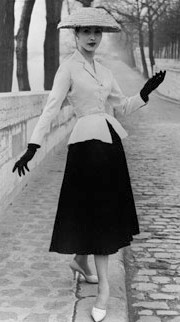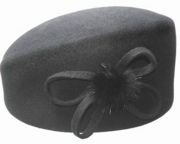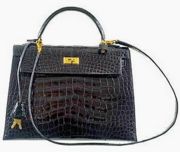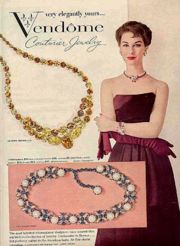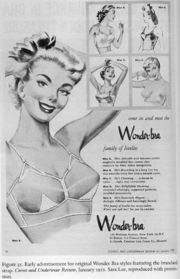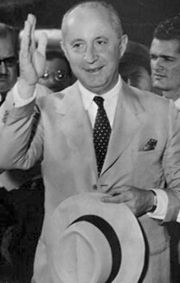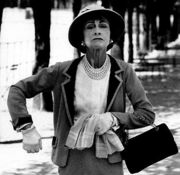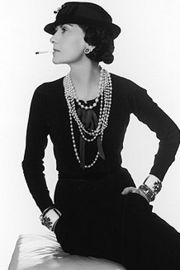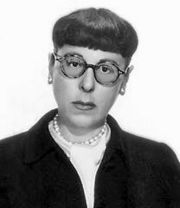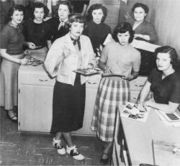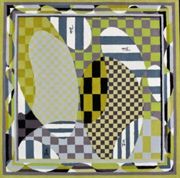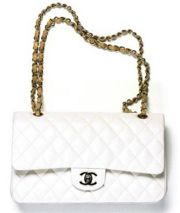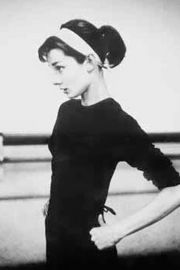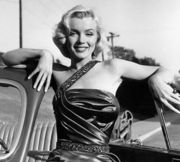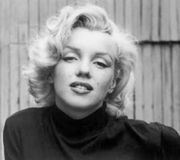Women's Fashion in the 1950's
From fifties
Contents |
[edit] Where Fashion Was Coming From
To understand 1950’s women’s fashion, let us first look back to the 1940’s.
[edit] During World War II:
Ladies’ fashions during World War II were largely influenced by the war itself. Textiles were scarce due to rationing, thus women’s dress hems became shorter, and dresses were often made of alternative materials. Synthetics began to be used, and many women modified their old clothing to make it more versatile. During WWII, the patchwork skirt was invented, and cork, rope, and wood, were used to make shoes. Fabric dye was also difficult to come by. Women began to make their own hats out of whatever materials were available, including newspaper, which was not rationed. Paris, which had been the fashion world’s epicenter, had begun to lose attention to Hollywood’s growing glamour. This would change in 1947, when Christian Dior, a Parisian couturier, would reveal his ‘New Look,’ to the world.
[edit] ‘The New Look’:
After the war’s end, ladies were eager for a change in their wardrobes, and Christian Dior offered a very appealing one. In 1947, he revealed his first ever collection, the Corolle line, in which he wanted to bring women’s fashions back towards femininity. He created two silhouettes for women that endured through the 1950’s, and was seen virtually on every woman in the 1950’s: emphasis on the bust, soft shoulders, a tiny waist, and full hips with a skirt that either fell straight, hugging the body until mid-calf, or blossomed out for more volume, until mid-calf. He used materials liberally, which coming out of the scrimping and saving of WWII, women enjoyed immensely. Carmel Snow, the editor of Harper’s Bazaar, an American fashion magazine, coined the name of the ‘New Look.’
[edit] End of the ‘40’s:
Also at the end of the 1940’s, cocktail dresses were invented, which stayed immensely popular through the 1950’s. And though Christian Dior helped Paris to recapture the world’s imagination, it is interesting to note that after WWII the fashion houses of Paris began a slow but steady decline. In 1946 Paris boasted 106 fashion houses, in 1956 sixty, thirty-six in 1958, and by 1967 only nineteen fashion houses remained. In 1949, Dior founded Christian Dior New York, and began to dress American women as well.
[edit] Definitions
A quick and simple guide to some fashion terminology.
[edit] What is Haute Couture?
‘Haute Couture’ is a French term that refers to the making of high-end garments by very few skilled craftspeople. These garments are made to measure. Presently haute couture also refers to the specific industry of couturiers, whom are under very strict regulations concerning quality and craftsmanship. The Chambre Syndicale de la Couture Parisienne protects and governs them. Haute couture is no longer the main focus of fashion houses. Twice a year, in fall and spring, the fashion houses will show their couture lines that are usually very creative and are the inspiration for that season’s ready-to-wear line.
[edit] What is Ready-To-Wear?
Ready-to-wear is just like it sounds. Designers create a clothing line in a variety of sizes that can be sold in their boutiques or in department stores for anyone to purchase. The term ready-to-wear comes from the French term ‘pret-a-porter.’
[edit] What are Fashion Houses?
Fashion houses began in Paris. A ‘maison couture’ was a place were the couturier set up shop and did their work. A fashion house also refers to what we might think of as the ‘brand,’ -The House of Chanel, the House of Balenciaga, the House of Cavalli, etc. These fashion houses do not just produce clothing. Many of them create handbags, jewelry, sunglasses, shoes, and make up. Perfume is a highly popular product of fashion houses, with Chanel being one of the first to release a perfume, Chanel No.5, in 1921.
[edit] Trends of the 1950’s
Certain elements of fashion were created or gained more popularity during the decade.
[edit] Accessories:
Many iconic looks came from the 1950’s. See which ones you’re familiar with.
- Winged glasses were very popular during the decade. Eyewear for women took on a subtle butterfly shape, and were often times decorated with rhinestones.
- Designer Cristobal Balenciaga showed his pillbox hat, which became wildly popular, and stayed popular into the 1960’s, as a favorite hat of Jackie Kennedy. 1950’s hat wearers preferred flowers to feathers when it came to hat decoration, and tightly fitted cloche hats came into favor. However, in the late ‘50’s, hats began to fall out of fashion, as women spent more time on their hair. No one wanted to ruin a fancy new hairstyle with a hat!
- Gloves were a staple in every well-groomed woman’s closet. White or cream colored gloves were very popular because in displaying their cleanliness, the wearer was reflected upon as a lady. Gloves were usually purchased in cotton or nylon because they were less expensive and easier to clean and take care of. Gloves were always worn on a fancy night out –the shorter the sleeve, the longer the glove.
- Metal-tipped stiletto heels were all the rage in the 1950’s. First seen in 1952 at a Dior fashion show (designed by Roger Vivier), stilettos skyrocketed into popularity after master shoe designer Salvatore Ferragamo created a pair of steel-reinforced stilettos for Marilyn Monroe in 1955. High heels were the mark of a lady, and pointy toes were preferred. The heels were made with steel in the hopes that they would last longer.
- Handbags began to gain popularity in the 1950’s. As women had more things to carry, purses began to make sense. Two iconic purses came out of the 1950’s that are considered fashion staples to this day: The Hermes “Kelly” bag (so named for it’s popularity with Grace Kelly), and Chanel’s quilted leather bag that hung from a chain (the 2.55). Also popular during the 1950’s were square bags made of hard, translucent plastic. These were a sensation in the United States especially as the plastic bag had just been invented. For women who could not afford luxury bags, homemade crotcheted bags made of raffia were popular.
- Costume jewelry came into popularity during the decade. As families began to move up the financial ladder and fashions became more glamorous, women wanted to wear fantastic jewelry. Coco Chanel is credited for bringing women costume jewelry. With costume jewelry, a lady could wear a large sparkling cocktail ring that looked expensive, but was actually quite inexpensive. Costume jewelry allowed more opportunity for dressing up, and was worn by many Hollywood leading ladies. Also incredibly popular in the 1950’s were pearls and pearl chokers, which were considered very elegant and feminine.
- Lastly, an important accessory for women in the fifties was the brassiere. To achieve the high, prominent bust that was in fashion at the time, cone shaped bras were highly necessary.
[edit] Materials:
The end of WWII marked a time of excess and prosperity. Women were thrilled to have more options in terms of textiles and color. The ‘50’s were a time when women craved luxury, elegance, and Hollywood glamour.
- Fur came back into favor in the 1950’s. Whether worn as a chic mink stole, or used to trim collars and sleeves, fifties women were in love with fur.
- Denim was the material of the rebel. Denim blue jeans were growing in popularity, and made ever more popular by appearing in Hollywood movies.
- Three man-made textiles came into prominence in the fifties: nylon, polyester, and orlon (acrylics). They were affordable and made clothes easier to care for. These new fabrics were easier to clean, and usually did not need ironing. Polyester was able to keep the look of tailoring even after being washed.
- Other popular fabrics of the decade: velvet, transparent fabrics such as chiffon and tulle, taffeta, silk (including silk crepe, and silk linens), tweed, and gold lame.
[edit] Shaping a Decade: Four Key Designer Profiles
By looking at these four designers of the 1950’s we can get a clear idea as to how women’s fashion during the decade was emerging and changing.
[edit] Christian Dior: Bright, Brilliant, and All Too Brief
Christian Dior’s New Look, called the Corolle line (which means ‘ring of petals,’ in French), premiered on February 12, 1947, revolutionizing women’s fashion. In his memoir, Dior wrote in reference to his first collection, “I have created flower women…” Dior was partial to using boning in his bodices to create tiny waists, and petticoats to help create full skirts. He was also partial to lavish materials, very unlike the war-time materials available, and intricate embroidery. Dior was also known for his detailed draping and tucks and bows. However, not all women were impressed with his ‘New Look.’ Many women decried his lengthened skirts (which used between 30 and 50 yards of fabric) and bustier like bodices, saying they were too extravagant. In the early ‘50’s, Dior began to experiment with making the body seem longer, and using large collar-less necklines. He also founded Dior Delman, for the customized making of shoes (which designer Roger Vivier ran). By 1954, Dior had created the H-Line, which elongated and freed the waist, and attempted to make the bust less pointy looking. In 1955 he began with the A-Line, where narrow shoulders and a wide hem were present, and finished the year with the Y-Line, a complete flip-flop of the A-Line, in which the shoulders were broad, and the hem was close to the body. Also in 1955, Dior’s beauty product line was launched. In 1957, only ten years into his meteoric rise, the fashion world was stunned, when Christian Dior died of a heart attack, leaving his fashion house to be run by his one and only personal assistant. Yves Saint Laurent would be the artistic director until 1961, when he would create his own successful couture house.
[edit] Coco Chanel: The Comeback Queen
Coco Chanel opened the House of Chanel in 1910. She was groundbreaking, creating free and easy frocks for wealthy women, with an emphasis on clean cuts and simplicity. In 1926, she created the “Little Black Dress,” that can still be found in almost any woman’s closet today. However, in 1939, at the start of WWII, Chanel was forced to close her boutiques. In 1953, at the age of seventy, Coco Chanel returned to the Rue Cambon 21, the site of her original boutique, and re-opened its doors. Chanel despised Dior’s New Look, deeming it to be antiquated and stifling for women. In 1954, she premiered her new line of chic, tweed women’s two piece suits. As far as silhouette, they were much clunkier looking than Dior’s flower women, but nevertheless they caused a sensation. Chanel insisted that women look tailored yet not have their movements impaired. She was known to rip sleeves off her suits until they had the ‘perfect’ fit. In 1957, her quilted leather shoulder bag that hung from a chain became one of the world’s most coveted purses. The design lives on today and is considered the handbag every woman should own. Neiman Marcus gave her an award in the year of its creation, and it was the only visit Coco Chanel would ever make to the United States.
[edit] Hubert de Givenchy: The Visionary
In 1951, Hubert de Givenchy opened his fashion house in Paris. His first famous design was the ‘Bettina’ blouse, so named for famed fifties model Bettina Graziani. In 1953, he met fellow designer Cristobal Balenciaga (another well-known and respected designer in the 1950’s whose House lives on today) and developed a friendship that would last throughout their careers. It was in 1954 though, that Givenchy would meet his muse, Audrey Hepburn. When Hepburn appeared at his House, Givenchy was most disappointed, as he had thought he was scheduled to see Katherine Hepburn. The disappointment would quickly fade and be replaced with adoration and a forty-year long partnership of a couturier and his muse. This was the first of its kind and caliber that anyone had ever seen. Together, Hepburn and Givenchy would make their names famous. Givenchy helped Hepburn to become a style icon, being her personal stylist and creating some of her most famous costumes, including the black dress in Breakfast at Tiffanys, and the cigarette style pants and loose fitting sweater in Funny Face. Hepburn helped Givenchy’s name and garments become world-renowned. In 1956, Givenchy banned the press from his couture house, saying, “A fashion house is a laboratory which must conserve its mystery.” In 1958, Givenchy revealed a shift dress that he called ‘the sack.’ It featured a straight waist-less look. As this look was modified in the late ‘50’s, it would later morph through other designers into the ‘60’s beloved mini dress. Throughout the 1950’s Hubert de Givenchy would be known and respected for his elegant designs and creative visions.
[edit] Edith Head: Dressing Hollywood
During the 1950’s Americans began to turn their back on Europe’s haute couture. For many, it seemed too stuffy and rigid. Hollywood, however, reeked of glamour and sparkle. The designs were very similar to many European fashions, but somehow, the dresses on Lauren Bacall, Marilyn Monroe, and Elizabeth Taylor made them look longer, leaner, and sexier. One of the many designers responsible for the designs in Hollywood was Edith Head. During her career she ran the costuming departments in both the Paramount and Universal studios. Part of what made Head so beloved and valuable was her ability to pick up on the trends of the time, and make them her own. She squabbled with Hubert de Givenchy over who should be credited for design for Sabrina, as most of Hepburn’s clothes in the film were inspired by his designs. She also had an eye for tailoring to mask an actress’ flaws and emphasize her beauty. When Olivia de Havilland first came to Paramount she was considered overweight. In one scene Head dressed her in pale blue and Paulette Goddard in bright white, which made the two women appear to be the same size. Head also dressed de Havilland in the film The Heiress, in which de Havilland was supposed to play an insecure woman. Head made de Havilland’s costumes too small so that she would always feel uncomfortable. When Head designed a white party dress with a daisy-covered bust for Elizabeth Taylor in A Place In The Sun, teenage girls went crazy over it. It was that season’s most popular prom dress. Head was Natalie Wood’s favorite designer. She even had Head create her wedding dress for her second marriage. In the 1950’s, Edith Head was America’s top designer.
[edit] The Birth of the Teenager
Only later would we see how much of an impact teenage girls would have on the future of the fashion industry.
[edit] Rebels With a Cause:
Prior to the 1950’s, the term teenager had not yet been coined. Young girls wore the same fashions as their mothers only as smaller, cheaper, and simpler versions. But by the fifties, teenagers had become their own market. With rock music, magazines, television shows, and films being aimed at teenagers, and with the affluence of the post-war world, teenagers had their own ideas, opinions, and most importantly, money to spend. For the first time, boutiques specializing in “young miss” apparel appeared. Teenage girls of the decade bucked the glamour and sophistication that their mothers so admired. Rebellion was the name of the game for the teenage girl. Instead of their mother’s longer full skirts, teen girls enjoyed shorter pleated skirts, or a full skirt with plenty of petticoats underneath. They also enjoyed the freedoms of Capri pants, the brainchild of Italian designer Emilio Pucci. Instead of stilettos, they preferred ballet flats. Teen girls idolized the simple, pretty style of Brigette Bardot, and the sexiness of Lana Turner and Jane Russell in their tight sweaters. Jewelry marketed to teen girls was made of soft plastic, glass, wood, and sometimes straw. Scarves tied saucily around the neck were also popular. Some teenage girls attempted a foray into wearing jeans. Others, influenced by the beatniks wore all black sweaters, and stirrup leggings. In reality, it is probably the new teenage culture in the ‘50’s that so influences fashion forever after. By the 1960’s, fashion houses are heavily influenced by street fashions, those fashions worn by young people and outside groups that was different from the norm. This was a monumental change, for instead of the population dressing as the fashion houses dictated, the fashion houses were drawing off the population. Had it not been for the ‘50’s teenage rebellion, the future of fashion may have been very different.
[edit] 1950’s Fashion and the Women Who Wore It: Changing the Face of the Fashion World
During a decade of change, fashion would not be exempt.
[edit] Italy Emerges:
Also during the ‘50’s, Italy, out from under Fascist rule, was in the process of becoming a new fashion mecca. Rome began to vie for the title of fashion capitol. Emilio Pucci was one of the Italian designers to emerge in the 1950’s. He presented his first women’s summer wear collection in 1949 on the isle of Capri. He later set up shop in Florence. His next collection was a sports collection, of ski, tennis, and golf wear. However, he is probably most known for his flirty Capri pant in 1954, named after the Italian island, and a huge success. In this same year he also released brightly colored silk scarves, with new prints (later called ‘Pucci Patterns’). During the ‘50’s he also worked to improve the stretch weaving for sportswear and in 1958 he discovered the elasticity of Shantung silk, and began to use it to create pants. Italian designers were becoming a force to be reckoned with.
[edit] The Dawn of a New Era:
The 1950’s were important years of change for the fashion industry. While Dior’s New Look in the late ‘40’s brought prestige back to Paris, the fashion world was rapidly changing. American women were still heavily influenced by the fashion houses across the Atlantic, but their eyes were turning towards the West coast, where Hollywood presented similar, yet different views of fashion. Dior brought women back to their feminine sides after the war, and Chanel reminded them that functionality was just as important as beauty. Givenchy was the embodiment of elegance, while Head was the mistress of glamour. New materials meant clothes were easier to care for, and costume jewelry meant any woman could adorn herself with jewels for a fraction of the cost. As American women began to emulate Hollywood styles, European women also began to crave American fashions. Movie stars around the world began to flock to Rome and its couturiers, and American teenagers, with their casual carefree style, were changing the face of the American fashion industry. As the decades wore on America would be known for their enthusiasm for and glorification of youth and their embrace of casual, comfortable clothes. The young people of the 1950’s were the beginning of the revolution.
[edit] 1950’s Style Icons:
Two women with very different styles, still regaled for their individuality.
[edit] Audrey Hepburn: The Epitome of Elegance
Hubert de Givenchy dressed Audrey Hepburn in many of her films and in her day-to-day life. Her stick thin, model like figure was a favorite of designers, because she showcased their clothing so well. Edith Head enjoyed dressing Hepburn early on in her career, but Givenchy was Hepburn’s designer of choice. She once said, “I depend on Givenchy in the same way that American women depend on their psychiatrists.” Givenchy claimed that while the clothing was his design, Hepburn made them her own by adding special pieces of jewelry and interesting accessories. If Chanel invented the little black dress, Hepburn’s opening scene in Breakfast at Tiffanys, in which she wears a black Givenchy dress, was the reason why women ran to stores to get their own little black dress. “It was as though I was born to wear his clothes,” Hepburn said of Givenchy. She often gave her opinion and ideas to him as he designed for her. In her every day life she preferred close fitting slacks, flat shoes and large sweaters, which she made equally as alluring. She was a minimalist, admired for her grace and poise.
[edit] Marilyn Monroe: Image of a Sex Goddess
While inside she was an insecure, small-town girl, Monroe’s Hollywood image was anything but. Perhaps one of the sexiest starlets to strut the silver screen, Monroe’s iconic look was built in the imaginations of men and women the world over. Early in her career she had tried to model, but soon photographers realized that her body actually distracted from the clothes she wore. Edith Head once dressed Monroe during the beginning of her career for the film All About Eve, but resented the fact that Monroe never asked her to design for her outside of the studios. Monroe was supposedly concerned about keeping her sexy image and worried that Head may not have the skills of other designers. She was one of the first female stars to be photographed in jeans, and she once said that, “Putting a girl in overalls is like having her work in tights, particularly if a girl knows how to wear them.” Monroe made two white dresses very famous, one in the 1955 movie The Seven Year Itch, in which her dress blows up around her as she stands on a subway grate. The second was a dress designed by Jean Louis that she wore to John F. Kennedy’s birthday party, where she sang to him, and where when the spotlights hit the dress, it was nearly transparent. Monroe would not stand for ‘panty-lines’ distracting from her curves, and would often times not wear underwear under her gowns (some of which were so form-fitting, she was sewed into them). Marilyn Monroe was a voluptuous, show-stopping beauty, whose image continues to inspire women today.
[edit] Bibliography
Affaticati, Andrea., Arnold, Rebecca., Breward, Christopher., et. al. Icons of Fashion: The 20th Century. New York: Prestel, 2005.
Buttolph, Angela., Doe, Tamasin., et.al. The Fashion Book. London: Phaidon Press Limited, 1998.
Garcia, Nina. The Little Black Book of Style. New York: HarperCollins, 2007.
Sarvady, Andrea. Leading Ladies: The 50 Most Unforgettable Actresses of the Studio Era. San Francisco: Chronicle Books, 2006.
Paxton, Anne. “The Magic of Edith Head.” Suite 101. http://www.suite101.com/article.cfm/womens_fashion/96452/2 (25 May 2008)
Fashion-era. http://www.fashion-era.com/1950s/index.htm ( 27 May 2008)
